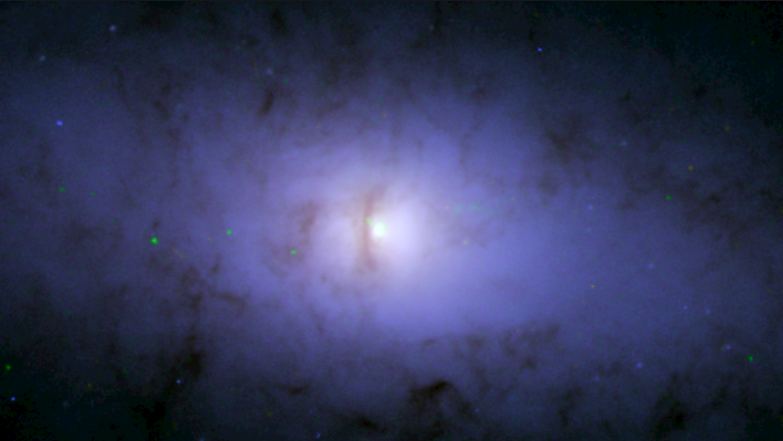Black holes are often thought of as cosmic anchors, spinning in perfect alignment with their host galaxies. However, astronomers have recently uncovered a stunning anomaly—a supermassive black hole in the galaxy NGC 5084 that is tipped completely sideways, defying conventional understanding of galactic dynamics.
The Mystery of NGC 5084
NGC 5084, a lenticular galaxy located approximately 80 million light-years away, has long been a subject of study since its discovery by German astronomer William Herschel in 1785. While it initially seemed like a typical galaxy, recent observations have revealed that it harbors a highly unusual supermassive black hole at its core.

Unlike most black holes, which align with the plane of their host galaxy, the black hole in NGC 5084 is spinning at a 90-degree angle relative to the galactic disk. This misalignment is unprecedented and raises intriguing questions about the galaxy’s turbulent past and the forces at play within its core.
How Astronomers Made the Discovery
The discovery was made possible through the innovative SAUNAS technique (Selective Amplification of Ultra Noisy Astronomical Signal). Developed at NASA’s Ames Research Center, SAUNAS enhances the visibility of faint X-ray emissions by filtering out interference from other radiation sources.
When applied to archival data from the Chandra X-ray Observatory, SAUNAS uncovered four plasma plumes emanating from the galaxy’s center—two aligned with the galactic plane and two perpendicular to it. This cross-shaped pattern of emissions suggested an unusual configuration at the heart of NGC 5084.
To confirm these findings, astronomers turned to additional data from the Hubble Space Telescope, the Atacama Large Millimeter/submillimeter Array (ALMA), and the NRAO’s Expanded Very Large Array. These observations revealed a dusty inner disk orbiting the black hole, spinning in a direction completely misaligned with the galaxy’s overall structure.
A Chaotic Past: How Did the Black Hole Tip Over?
The tilted orientation of the black hole and its surrounding disk suggests a violent history for NGC 5084. One plausible explanation is that the galaxy experienced a major collision or merger with another galaxy, disrupting its internal structure and causing the black hole to tilt.
Galactic mergers are known to generate immense gravitational forces, capable of altering the dynamics of both stars and black holes. The presence of four plasma plumes further supports this theory, as such emissions are often associated with energetic events like mergers or the ejection of material from a black hole.
Alejandro Serrano Borlaff, the lead author of the study, described the discovery process as piecing together a crime scene: “It was like seeing a crime scene with multiple types of light. Putting all the pictures together revealed that NGC 5084 has changed a lot in its recent past.”
Why This Discovery Matters
The sideways black hole challenges long-held assumptions about the relationship between galaxies and their central black holes. Traditionally, scientists believed that black holes grow and spin in alignment with their galaxies, driven by a shared evolutionary history. This discovery suggests that this alignment is not always guaranteed, particularly in galaxies that have undergone significant disruptions.
What’s Next for Research?
The discovery of a tilted black hole is just the beginning. Future studies will likely focus on identifying other galaxies with similar misaligned black holes and exploring the underlying mechanisms behind such anomalies.
One promising avenue of research involves using next-generation telescopes like the James Webb Space Telescope (JWST) to study the environments around these black holes in greater detail. Infrared observations from JWST could reveal more about the dusty disk and the processes fueling the black hole’s activity.
Additionally, understanding the role of magnetic fields and angular momentum in tipping black holes could provide new clues about the interplay between galaxies and their central engines.
Why Should We Care About Black Holes?
Black holes are not just exotic objects; they are fundamental to our understanding of the universe. They influence the formation and evolution of galaxies, regulate star formation, and serve as natural laboratories for studying the laws of physics under extreme conditions.
The tilted black hole in NGC 5084 is a reminder of the universe’s complexity and unpredictability. It challenges us to think beyond established paradigms and embrace the unknown.
Conclusion
The discovery of a sideways black hole in NGC 5084 is a testament to the power of innovation and perseverance in astronomy. By combining advanced techniques with archival data, astronomers have uncovered a cosmic anomaly that defies expectations and opens new doors for exploration.



















